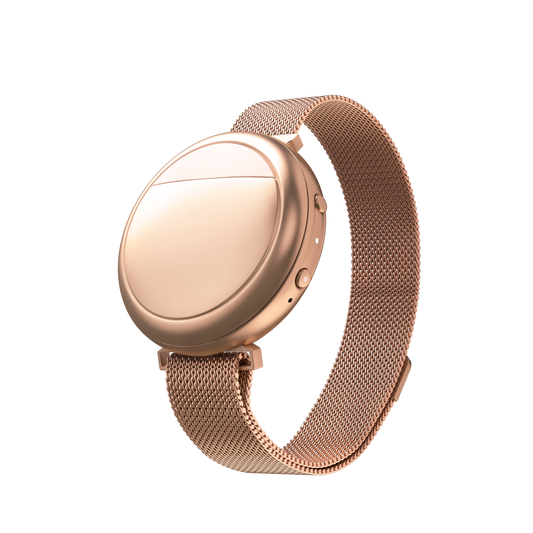Menopause is a natural life stage but that doesn't mean you have to suffer through it. Hot flashes, night sweats, mood swings, and vaginal dryness can disrupt sleep, relationships, and overall quality of life. You deserve care that helps you feel like yourself again.
One way to treat menopause symptoms is with menopause hormone therapy (MHT). You might also hear it called hormone therapy (HT) or hormone replacement therapy (HRT).
This guide breaks down what MHT is, how it works, and what to discuss with your doctor when deciding if it's right for you.
What is menopause hormone therapy?
As you go through menopause, your body will eventually produce less estrogen naturally. That shift can lead to symptoms like hot flashes, sleep issues, vaginal dryness, and mood changes.
MHT is a prescription treatment that contains estrogen to replace the estrogen your body is no longer making (or making less of). You provider may suggest different combinations of estrogen and progesterone depending on your age, symptoms, and medical history — especially if you're over 60 or have specific health conditions.
MHT can be made in a lab or come from a variety of plant or animal sources. There are both synthetic (man-made in a lab) and ‘natural’ (plant/animal compounds that have been altered in a lab) forms that have been approved by the U.S. Food and Drug Administration (FDA).
The chemical structure is often the same as the hormones naturally produced by your body, what some people might call "bioidentical". The body recognizes MHT as estrogen, progesterone, or testosterone and uses a dedicated receptor on the cell to accept the MHT in order to perform its dedicated functions.

It's important to know that not all types of commercially available MHT are FDA-approved. Choosing an FDA-approved options means you're getting medication that's been rigorously tested for safety and effectiveness. In addition to being safer, FDA-approved options (versus compounded) may be less expensive.
Types of hormone therapy for menopause
Menopause hormone therapy isn't one-size-fits-all. There are different formulations and ways to take it, depending on your body, your symptoms, and your health history.
Estrogen-only therapy
This type is typically prescribed for those who've had a hysterectomy and no longer have a uterus. It’s often referred to simply as estrogen therapy and can help ease symptoms like hot flashes and vaginal dryness. It can be taken orally or absorbed through the skin (with a cream, gel, spray, or patch).
Estrogen + progestogen therapy
If you have a uterus, estrogen can make the lining grow. To keep it healthy and lower the risk of problems like abnormal cells or cancer, your provider will recommend combining estrogen with a progestogen (a form of progesterone) to help protect the uterus. This helps protect against endometrial/uterine cancer and may also improve sleep, reduce hot flashes, and ease night sweats. You might hear this called "combined hormone therapy".
How you take MHT matters
There are two main ways to take hormone therapy: systemic (higher dose) and low-dose vaginal products.
Systemic therapy
This option contains a higher dose of estrogen that travels through your bloodstream to treat some of the common body-wide symptoms of menopause. It comes in several forms: oral pill, skin patch, gel, or spray.
Low-dose vaginal products
These products focus on treating vaginal and urinary menopause symptoms, like dryness, discomfort, or frequent UTIs. Because they're applied directly to the vaginal area, a negligible amount is absorbed into the body. They're available as vaginal rings, tablets, or creams. Because these aren't considered systemic, local therapy is typically considered safe for nearly everyone.
In some cases, systemic and local therapies can be used together to effectively treat systemic and local symptoms.
Every person's experience with menopause is different. That's why it's important to talk with your healthcare provider about what type of therapy and delivery method might be right for you.

Potential benefits of menopause hormone therapy
Menopause hormone therapy (MHT) can offer real relief and support during a time of major change. While it's not for everyone, many find that MHT helps them feel more like themselves again.
Here are some of the potential benefits:
- Relief from hot flashes and night sweats. Systemic estrogen is still the most effective treatment for managing moderate to severe hot flashes and night sweats.
- Managing other symptoms of perimenopause and menopause. Estrogen can ease vaginal dryness, itching, and discomfort during sex.
- Protection against bone loss. Estrogen helps maintain bone mass and may reduce your risk of osteoporosis and fractures, particularly in those diagnosed with osteopenia, or low bone mass.
- Help for early menopause or estrogen deficiency. If you've gone through menopause early — due to surgery, health conditions, or other factors — your body has had less exposure to estrogen. You may have had ovaries removed, stopped having periods before age 45, or lost normal function of your ovaries before age 40. Estrogen therapy is very important in the case of early menopause, lowering your risk for certain health conditions, including heart disease.
Even if you're past the typical menopause transition age, MHT may still offer benefits. Your provider can help you explore low-dose and localized options that fit your needs.
Like any medication, MHT can have side effects, some of which can be serious. They vary depending on the type and format you use. Some people may not be good candidates for MHT, for example if they have a history of certain cancers. Talk to your doctor about the potential side effects and whether MHT is right for you.
If you’re ready to explore your options, consider setting up a virtual visit with a menopause care provider through our Menopause Care Directory.
Not sure where to start? Bring a list of your symptoms (en Español) and questions to your appointment. Your provider can help guide you through the options.
Hormone therapy: Not just for menopause
Hormone therapy isn't just for menopause or reproductive hormones. It's a broader medical approach used in many situations where the body isn't making enough of a certain hormone. For example, people with diabetes may take insulin, and those with an underactive thyroid often need thyroid hormone replacement. These are all forms of hormone replacement therapy (HRT).
When it comes to menopause, the term is getting more specific. That's why you'll often see menopause hormone therapy (MHT) or hormone therapy (HT) used instead. It refers directly to treatments that help manage symptoms caused by lower estrogen levels during menopause.
MHT is one tool that can help ease the transition, especially if you're dealing with hot flashes, sleep issues, vaginal dryness, or other symptoms. But just like menopause itself, treatment isn't one-size-fits-all. Your decision to use MHT may depend on your symptoms, your medical history, and how you're feeling over time. And it's totally okay for that decision to evolve.
You're in charge of your care. Whether you choose MHT or another approach, what matters most is that you feel supported and informed.
The best way to know if MHT is right for you? Talk with your doctor. They'll help you weigh the benefits and risks based on your unique needs. And don't forget to check in regularly. Your body's needs can change and your treatment plan should too.
FAQs
Can hormone therapy increase the risk of cancer?
Yes, some types of MHT may increase the risk of breast cancer for some people with specific risk factors, especially with long-term use. Your doctor can help you choose the safest option based on your health history. Many people safely use MHT for years. The key is regular check-ins and personalized care that weigh the risks and benefits.
What’s the best way to treat vaginal dryness during menopause?
Low-dose vaginal estrogen products are designed to treat vaginal dryness and discomfort during sex. They also decrease urinary tract infections. They work locally and have minimal impact on the rest of your body.
Are there non-hormonal treatment options for menopause symptoms?
Yes. If you’re not a candidate for MHT or prefer not to take hormones, other treatment options include lifestyle changes, non-hormonal medications, and supplements. Your provider can help you find what works best for you.
References
Davis, S.R., et al. (2019). Global consensus position statement on the use of testosterone therapy for women. Climacteric, 22(5): 429-434. DOI: 10.1080/13697137.2019.1637079
Fait, T. (2019). Menopause hormone therapy: Latest development and clinical practice. Drugs Context, 8: 212551. doi: 10.7573/dic.212551
Johns Hopkins Medicine. Thyroid hormone replacement therapy. Accessed 1/17/23 from https://www.hopkinsmedicine.org/health/treatment-tests-and-therapies/thyroid-hormone-replacement-therapy
Mayo Clinic. (2022). Hormone therapy: Is it right for you? Accessed 1/17/23 from https://www.mayoclinic.org/diseases-conditions/menopause/in-depth/hormone-therapy/art-20046372.
MedlinePlus. (2019). Hormone replacement therapy. Accessed 1/17/23 from https://medlineplus.gov/hormonereplacementtherapy.html
NIH National Cancer Institute. (2018). Menopausal hormone therapy and cancer. Accessed 1/17/23 from https://www.cancer.gov/about-cancer/causes-prevention/risk/hormones/mht-fact-sheet
Prior, J. C. (2018). Progesterone for treatment of symptomatic menopausal women, Climacteric, 21(4): 358-365, DOI: 10.1080/13697137.2018.1472567
Scott, A. & Newton, L. (2020). Should we be prescribing testosterone to perimenopausal and menopausal women? A guide to prescribing testosterone for women in primary care. Br J Gen Pract, 70(693): 203-204. doi: 10.3399/bjgp20X709265
The Menopause Society. Menopause topics: Hormone therapy. Accessed 10/30/2024 from https://menopause.org/patient-education/menopause-topics/hormone-therapy
The American College of Obstetricians and Gynecologists. (2022). Hormone therapy for menopause, frequently asked questions. Accessed 1/17/23 from https://www.acog.org/womens-health/faqs/hormone-therapy-for-menopause
University of Rochester Medical Center. Insulin replacement therapy. Accessed 1/17/23 from https://www.urmc.rochester.edu/encyclopedia/content.aspx?contenttypeid=85&contentid=P00344
U.S. Food and Drug Administration. (2019). Menopause & hormones: Common questions. Accessed 1/17/23 from https://www.fda.gov/media/130242/download
Links to other parties' articles and websites are provided for convenience only. Kenvue is not responsible for their content.







5 comments
I need something for severe hot flashes and night sweats
Necesito aserme el remplazo de hormonas
Nesecito aserme el replaso hormonal
I need estrogen or something for dry vagina
Keep up the good work!